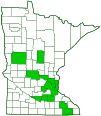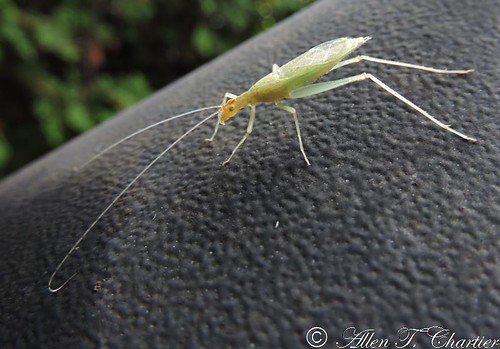snowy tree cricket
(Oecanthus fultoni)
Conservation • Description • Habitat • Ecology • Use • Distribution • Taxonomy
Conservation Status |
|
|||||||
| IUCN Red List | not listed |
|||||||
| NatureServe | NNR - Unranked |
|||||||
| Minnesota | not listed |
|||||||
Description |
||
Snowy tree cricket, sometimes called thermometer cricket, is a common singing insect. It occurs throughout the United States, southern Canada, and Mexico. In the contiguous U.S., it has been recorded in every state except Florida, Mississippi, and Montana. Though called a tree cricket, snowy tree cricket is found on a wide variety of deciduous trees, shrubs, vines, and forbs. It is rarely found on grass. It is common on shrubs and vines around houses, on fruit trees that have not been sprayed with insecticides, in fence rows, and at woodland edges. Males are often heard high in oak trees. Adults are active from August to October. They feed on plant leaves and fruit. When feeding on leaves, they do little damage to the plant. When feeding on fruit they leave holes which causes the fruit to rot. If the tree is sprayed, they do not cause significant damage. Nymphs feed on leaves and flowers. Adults are light green, translucent, and ⅝″ to 11⁄16″ (15 to 18 mm) in length. The body is long and slender. The head is small. The area between the eyes is tinged with orange, orangish yellow, or orangish red. There are two compound eyes and no simple eyes (ocelli). The antennae are longer than the body and are mostly colorless. There are 18 Oecanthus species in North America north of Mexico. They are very similar in appearance and are usually identified by the markings on the first and second antennal segments. This character is difficult to observe in the field, or even from most photographs, but it is very useful in determining the species. The first segment is pale orange except for a prominent, whitish, rounded swelling on the inner edge. The swelling has a single black, roundish spot. The second segment has a similar but much smaller swelling. This swelling has a single black, elliptical spot. The spot is more than half as long as the segment. The pronotum is longer than wide. It is slightly narrower in the front than in the rear. The corners of the lower lobes are rounded. The orange tinting on the head does not continue onto the pronotum. The leathery front wings (tegmina) on the male are translucent, flat, and rigid. They are much wider than the abdomen. The tips are broadly rounded. On the female, the tegmina are narrower and membranous. They are held tightly wrapped about the body. The legs are very slender. They are the same color as the body. The fourth segment (tibia) on the hind legs is armed with two rows of several long spines with numerous minute teeth between the spines. The last part of each leg (tarsus), corresponding to the foot, has three segments. The basal segment is longer than the other two combined. |
||
Size |
||
Total length: ⅝″ to 11⁄16″ (15 to 18 mm) |
||
Song |
||
|
|
||
The song is a broken series of pulses (chirp). Each chirp consists usually of eight pulses in three groups, one group of two pulses and two groups of three pulses. The chirps are of equal duration, and they are separated by intervals of almost equal duration. Chirps of five pulses are common, and sometimes the male alternates between eight and five chirps for several hundred chirps. Chirps with other numbers of pulses are rare. The chirps are easily counted, the pulses are not. East of the Great Plains, the air temperature can be estimated by counting the number of chirps in 13 seconds and adding 40. West of the Great Plains, count the chirps in 12½ seconds and add 38. The pulse rate of the song varies with the air temperature. At 65° F (20° C) there are about 36 pulses per second. At 75° F (25° C) there are about 52 pulses per second. |
||
Similar Species |
||
Habitat |
||
Woodland edges, shrubs and vines around houses, unsprayed fruit trees, and fence rows |
||
Ecology |
||
Season |
||
One generation per year: August to October (adults) |
||
Behavior |
||
Males sing mostly at night. |
||
Life Cycle |
||
Mating begins in August. Eggs are laid from September through October. The eggs overwinter and hatch in June the following year. The nymphs undergo paurometabolous development (gradual metamorphosis) and look like small adults. They take 13 months to mature into adults. |
||
Nymph Food |
||
Plant leaves and flowers |
||
Adult Food |
||
Plant leaves, flowers, and fruit |
||
Use |
||
Recordings of snowy tree cricket are used in television and movies in scenes depicting people in nature at night. |
||
Distribution |
||||
|
Sources Walker TJ. 1963. The taxonomy and calling songs of United States tree crickets (Orthoptera: Gryllidae: Oecanthinae). II. The nigricornis group of the genus Oecanthus. Ann. Entomol. Soc. Am. 56: 772-789. |
|||
| 11/28/2023 | ||||
Occurrence |
||||
Common and widespread |
||||
Taxonomy |
|||
Order |
Orthoptera (grasshoppers, crickets, and katydids) |
||
Suborder |
Ensifera (katydids, crickets, and allies) | ||
| Infraorder | Gryllidea (crickets) | ||
Superfamily |
Grylloidea (true crickets and allies) | ||
Family |
Oecanthidae (tree crickets and bush crickets) | ||
Subfamily |
Oecanthinae (tree crickets) | ||
| Supertribe | Oecanthidi | ||
Tribe |
Oecanthini | ||
Genus |
Oecanthus (common tree crickets) | ||
Synonyms |
|||
The name Oecanthus niveus was long misapplied to this species. All references to Oecanthus niveus prior to 1962 actually refer to Oecanthus fultoni. The name Oecanthus niveus now refers to the narrow-winged tree cricket, and is therefore not a synonym of Oecanthus fultoni. |
|||
Common Names |
|||
snowy tree cricket thermometer cricket |
|||
Glossary
Ocellus
Simple eye; an eye with a single lens. Plural: ocelli.
Pronotum
The exoskeletal plate on the upper side of the first segment of the thorax of an insect.
Tarsus
On insects, the last two to five subdivisions of the leg, attached to the tibia; the foot. On spiders, the last segment of the leg. Plural: tarsi.
Tegmen
The modified, leathery front wing of grasshoppers and related insects that protects the hindwing. It may also serve as a camouflage, a defensive display, or a sound board. Plural: tegmina.
Tibia
The fourth segment of an insect leg, after the femur and before the tarsus (foot). The fifth segment of a spider leg or palp. Plural: tibiae.
Visitor Photos |
|||||
Share your photo of this insect. |
|||||
| This button not working for you? Simply email us at info@MinnesotaSeasons.com. Attach one or more photos and, if you like, a caption. |
|||||
Alfredo Colon |
|||||
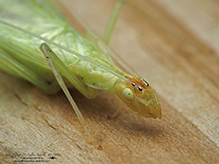 |
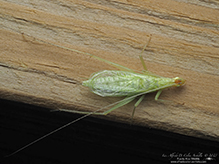 |
||||
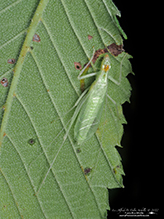 |
|||||
MinnesotaSeasons.com Photos |
|||||
|
|||||

Visitor Videos |
|||
Share your video of this insect. |
|||
| This button not working for you? Simply email us at info@MinnesotaSeasons.com. Attach a video, a YouTube link, or a cloud storage link. |
|||
Other Videos |
|||
| Oecanthus fultoni Laurel Symes |
|||
About
Sep 11, 2009 Calling male. The silent insect is a female. |
|||
| Oecanthus Fultoni singing Jozo Vrdoljak |
|||
About
Aug 17, 2015 |
|||

Created: 11/28/2023
Last Updated:
